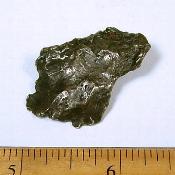Utah Septarian Nodules

Septarians were formed during the Cretaceous period, 50 to 70 million years ago when the Gulf of Mexico reached what is now Southern Utah. Decomposing sea life killed by volcanic eruptions, had a chemical attraction for the sediment around them, forming mud balls. as the ocean receded, the balls were left to dry and crack. Because of their bentonite content they also shrank at the same time trapping the cracks inside. As decomposed calcite from the shells was carried down into the cracks in the mud balls, calcite crystals formed. A thin wall of calcite was transformed into aragonite separating the bentonite heavy clay exteriors from the calcite centers. Because of this, the nodules are called Septarians.
The name Septarian is derived from the Latin name, Septem, meaning seven. This relates to the fact that the mud balls cracked with 7 points in every direction, thereby creating the beautiful design.
Septarians are composed of Calcite (The Yellow Centers), Aragonite (The Brown Lines) and the Outer Grey Rock is Limestone. Occasionally the fossil or some of the fossils which started the formation of the rock is noticeable in the rock.
Fossils of Southwest Wyoming
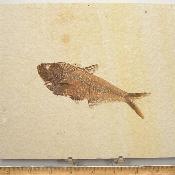
In southwest Wyoming (and parts of Colorado and Utah) in the Green River Formation are found some of the world’s most outstanding specimens of fossil fish.
The Green River system was composed of three lakes: Lake Ulinta, Lake Gosiute and Fossil Lake. These Eocene Lakes lay in a series of intermountain basins formed by geological events that uplifted the Rocky Mountains during the early Tertiery time.
The Climate was much different from the desert-like climate of this area today. Both the fauna (crocodiles, alligators, boa constrictors and some subtropical fish families) and the flora (such as large palm trees) indicate a climate much like that found along the Gulf Coast today. Large amounts of ash found in the sediments indicate that volcanoes were particularly active at this time.
The fossils found in the Green River Formation are between 40-60 Million years old and are in excellent preservation. The most common fish found in the formation is the Knightia, a herring-like fish. They are found singularly or in large groupings. These groupings are referred to as “Mortality Layers” and are believed to have been caused by extensive ash fall-out after volcanic eruptions.
Some of the other species of fish found in the Green River Formation are: Phareodus, a carnivorous fish often found up to 2 feet in length and having many sharp teeth. Mioplosus, a true perch, and Priscacara, a sunfish-like fish with stout dorsal and anal spines. There are also turtles, stingrays, crocodiles and alligator gar-fish.
The fossils of the Green River Formation – each one unique – are some of natures finest art. They are highly valued by collectors the world over.
Chrysanthemum Stone

These “Chrysanthemum” Flowers, frozen in stone, are natural occurrences of celestite crystals in a limestone matrix. Found in Liuyang County, of Hunan Province in China, The Chrysanthemum Stone Flower has been highly prized as a marvel of nature. Once polished and carved to show the wondrous flower, it is a soothing object for contemplation and meditation.
Obsidian
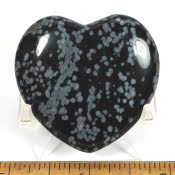
Obsidian forms when volcanic magma cools very quickly preventing the crystaline structure of granite to form. This produces volcanic glass. The various types of obsidian are caused by the following:
Mahogany obsidian: The rust color is caused by iron oxide
Sheen obsidian: The gold or silver iridescence is a result of tiny gas bubbles or very small crystals of mica, feldspar or quartz.
Snowflake obsidian: White inclusions of crystobalite.
Rainbow obsidian: The various bands of color are formed by very small inclusions of feldspar, quartz, topaz and tourmaline.
Moqui Marbles (Utah)

These have been called Iron Concretions for years but recently a study was made to find out their true origin. Moqui Marbles are iron concretions encasing pink sand from the seas that covered Utah millions of years ago.
They are found at the base of the Navajo Sandstone and are thought to be 130 to 135 million years old. These were once Mollusks which were trapped in a huge flood of sand. The juices of their bodies was pulled to the outside as they deteriorated leaving their centers hollow. Through the years, water filtered through their sand-formed outer rings, filling their centers with fine sand while the water deposited its iron in the outer shell which contained phosphorous and lime, from the Mollusk’s bodies.
Moqui Marbles
In Hopi the word Moqui means “dearly departed ones. “Moqui Marbles, according to Hopi legend, holds that in the evening Hopi ancestors descend from heaven with the marbles and play games. At sunrise, they return to heaven and leave the marbles behind to indicate to their loved ones that they are happy and well in the spirit world..” article source unknown. Keeping Moqui marbles in the home is considered a sign of welcome to one’s ancestors.
Crinoids

Crinoids are marine animals having a cuplike enclosing sac, or theca. The theca, plated with calcium carbonate, may be from 1/4″ to 2″ long. Highly branched arms growing from the upper surface are used for gathering food from the surrounding water and for exposing soft tissue for respiration. l The theca rests on a stem, rooted to the sea floor, that is about 2 ft long in some modern animals; stems up to 70 ft long have been found in fossil crinoids. Mesozoic to recent crinoids also include floating animals without stems. The fossil record of crinoids commences in the Cambrian Period and extends to the present. Stemmed crinoids flourished in the Paleozoic seas, and their remains are abundant in Paleozoic rock sequences. They nearly became extinct, however, at the close of the Paleozoic. Modern crinoid species include Feather Stars and Sea Lilies.
Fiber Optics

These spheres are made from the same material most of us know as Fiber Optics which is used in information transmission lines for our telephones, cable television and computers. This material is high purity silica which can aid in the transmission of signals at great distances. Fiber Optics has an interesting characteristic in that you can see thru the glass, or in this case the sphere in the direction that signals would pass well enough to read print when it is laid on a newspaper. When it is ground into a sphere and rotated 90 degrees you can no longer see through the fibers and it creates the interesting and intense cats-eye that you see in these spheres. This is similar to the eye or radiance you see in natural Tigereye stone.
Sikhote-Alin Meteorite
The Sikhote-Alin Meteorite fell at 10.38 a.m. local time on February 12, 1947 in Eastern Siberia. In full daylight, this meteorite broke apart in the Earth’s atmosphere. Appearing as a flaming fireball trailed by a smoke tail, the phenomenon flashed different colors as it made its way across the Russian sky. “The light was reported as being as bright as the sun. The sound wave scared thousands of people as it passed.
About 3.5 miles up from the ground, the largest mass broke apart in a violent explosion. This is a very low altitude for such and event to happen and is highly unusual. Many fragments were detached early in flight, these proceeded as “individuals” along with the main mass. Some of these show orientation or flighty marks.
When the main mass exploded, it created specimens that are referred to as “shrapnel”. The meteorites fell in a elliptical circle of about 1.6 kilometer on snow covered Sikhote-Alin Mountains. Some fell in trees while others helped create 122 impact craters with diameters from 26 to 0.5 meters and with depths measuring nearly twice the diameter of the craters.
The main mass is an amazing 1,745 kilogram specimen now on display in Moscow, many other specimens are in museums around the world. The meteorite itself is classified in the Group 11B, with about 5.9% nickel and includes minerals such as kamacite, taenite, plessite, schreibersite crystals, rhabites, troilite and chromite. The majority of this meteorite is of coarse iron.
Campo Del Cielo Meteorite
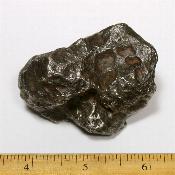
The Campo Del Cielo Iron Meteorite is from Gran Chaco Gualamba, Argentina. These Campo meteorites were first found in 1576. It probably impacted the earth nearly 6000 years ago leaving an extensive strewn field and more than 12 craters. The Campo Del Cielo Meteorites are a Coarse Octahedrite, Type 1A, (3mm crystal). They consist of an average composition of 92% Iron, 6% Nickel and other rare minerals with silicate inclusions.
Blue Celestite

Did you know that Celestite is a mineral form of strontium sulfate which is a metal. The metal strontium is mixed with carbon and sulfur and then used for the red fire in fireworks, flares and signal shells.
Strontium is also used in the nuclear industry as well as the manufacture of rubber, paint, electrical batteries and in the refining of beet sugar.
Celestite is a softer mineral having a hardness of 3 to 3.5 and therefore can easily be scratched with a knife blade, also it is slightly soluble in water.
How Does Wood Petrify?
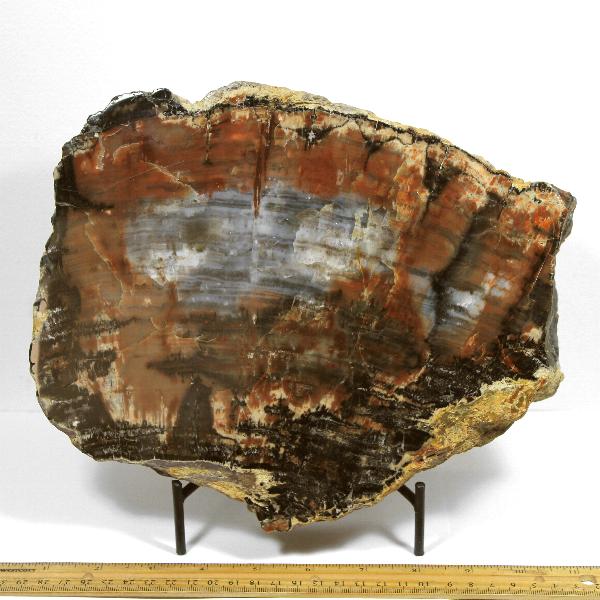
Wood must first be covered with such agents as volcanic ash, volcanic mud-flows, sediments in lakes and swamps or material washed in by violent floods – by any means which would exclude oxygen and thus prevent decay. A number of mineral substances (such as calcite, pyrite, marcasite) can cause petrification, but by far the most common is silica. Solutions of silica dissolved in ground water infiltrate the buried wood and through a complex chemical process are precipitated and left in the individual plant cells. Here the silica may take a variety of forms: it may be agate, jasper, chalcedony or opal. The beautiful and varied colors of petrified wood are caused by the presence of other minerals that enter the wood in solution with the silica. Iron oxide stains the wood orange, rust, red or yellow. Manganese oxide produces blues, blacks or purple. All of this combined with millions of years turns the once thriving tree to rock. Sometime the replacement of the cell structure of the tree is so complete that the growth rings, knots and other growth marks are still very obvious.
